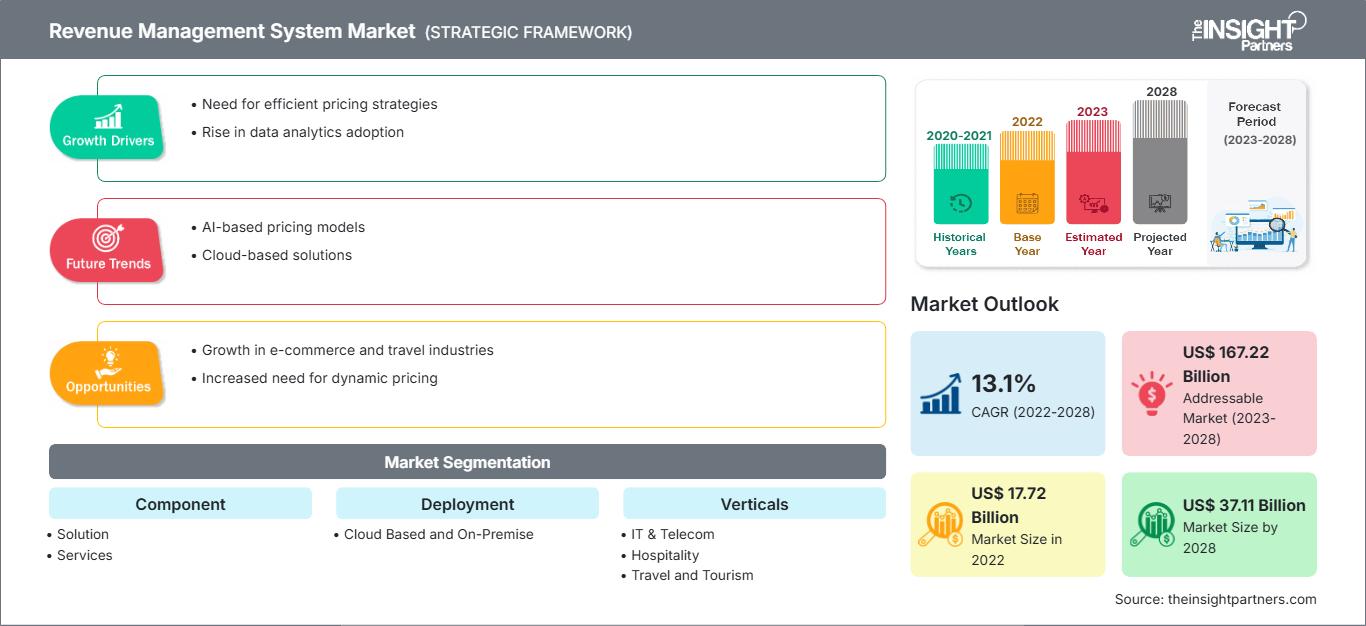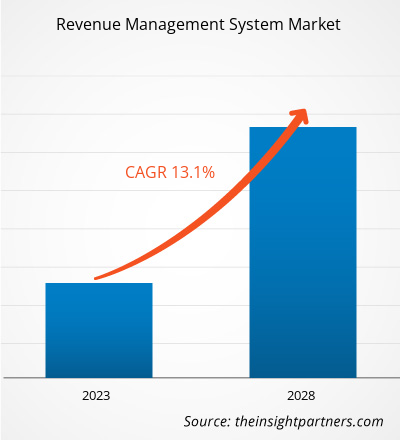Der Markt für Revenue-Management-Systeme soll von 17.717,02 Millionen US-Dollar im Jahr 2022 auf 37.106,75 Millionen US-Dollar im Jahr 2028 wachsen; von 2022 bis 2028 wird ein durchschnittliches jährliches Wachstum von 13,1 % erwartet.
Ein Revenue-Management-System umfasst Lösungen und Services, die es Unternehmen ermöglichen, ihren Umsatz durch automatisierte, effiziente Kundenzahlungen zu steigern und Umsatzverluste zu reduzieren. Mithilfe von Automatisierung und Analyse zielt die Revenue-Management-Software darauf ab, Umsatz und Rentabilität zu maximieren. Die Lösungen und Services eines Revenue-Management-Systems lassen sich sowohl in Buchhaltungssoftware als auch in ERP-Systeme integrieren. Dieses System integriert und analysiert historische Daten und Marktdaten für genaue Prognosen, bessere Betriebseffizienz usw. Es prognostiziert außerdem das Verbraucherverhalten, optimiert die Produktverfügbarkeit und beschleunigt Abrechnungs- und Zahlungsmethoden durch die Reduzierung von Risiken und Betrug. In den letzten Jahren gab es eine wachsende Nachfrage nach der Optimierung von Umsatzplattformen und Kanalmanagement. Geschäftsabläufe werden zunehmend abhängig von der Cloud und fortschrittlichen Automatisierungssystemen. Daher treiben zunehmende Upgrades bestehender Revenue- und Channel-Management-Systeme und der wachsende Bedarf an wettbewerbsfähigen Preisstrategien das Wachstum des Marktes für Revenue-Management-Systeme voran.
Der nordamerikanische Markt für Revenue-Management-Systeme ist in Kanada, die USA und Mexiko unterteilt. Die USA haben den größten Anteil am nordamerikanischen Markt für Revenue-Management-Systeme. Die hohe Internetdurchdringung in der Region ist der Hauptfaktor für die Einführung digitaler Lösungen in Branchen wie IT und Telekommunikation, Medien und Unterhaltung, Gesundheitswesen, Einzelhandel und E-Commerce sowie Versicherungen. Mehrere Versicherungsunternehmen im ganzen Land führen wettbewerbsfähige Prämienstrukturen für ihre Kunden ein. Dies beeinflusst die Einführung von Revenue-Management-Lösungen bei Versicherungsunternehmen zur Kundenanalyse und Prämienberechnung auf der Grundlage des landesweiten Wettbewerbs. Darüber hinaus verzeichnen die USA jährlich eine große Anzahl von Geschäfts- und Urlaubstouristen. Dies hat das Wachstum des Gastgewerbes im ganzen Land erheblich beeinflusst. Daher verfolgen viele Premium-Hotels und -Restaurants verschiedene Strategien, um mehr Kunden zu gewinnen. Dies trägt zusätzlich zur wachsenden Nachfrage nach Revenue-Management-Systemen im gesamten Gastgewerbe des Landes bei.
Passen Sie diesen Bericht Ihren Anforderungen an
Sie erhalten kostenlos Anpassungen an jedem Bericht, einschließlich Teilen dieses Berichts oder einer Analyse auf Länderebene, eines Excel-Datenpakets sowie tolle Angebote und Rabatte für Start-ups und Universitäten.
Markt für Revenue-Management-Systeme: Strategische Einblicke

- Holen Sie sich die wichtigsten Markttrends aus diesem Bericht.Dieses KOSTENLOSE Beispiel umfasst Datenanalysen, die von Markttrends bis hin zu Schätzungen und Prognosen reichen.
Sie erhalten kostenlos Anpassungen an jedem Bericht, einschließlich Teilen dieses Berichts oder einer Analyse auf Länderebene, eines Excel-Datenpakets sowie tolle Angebote und Rabatte für Start-ups und Universitäten.
Markt für Revenue-Management-Systeme: Strategische Einblicke

- Holen Sie sich die wichtigsten Markttrends aus diesem Bericht.Dieses KOSTENLOSE Beispiel umfasst Datenanalysen, die von Markttrends bis hin zu Schätzungen und Prognosen reichen.
Auswirkungen der COVID-19-Pandemie auf das Marktwachstum von Revenue-Management-Systemen in Europa
Die COVID-19-Pandemie verursachte massive Störungen im Wachstum verschiedener Branchen in Spanien, Italien, Deutschland, Großbritannien und Frankreich. Unternehmen in Europa gerieten in schwere wirtschaftliche Schwierigkeiten, da sie ihren Betrieb entweder einstellen oder ihre Aktivitäten erheblich einschränken mussten. Darüber hinaus bremste der Rückgang der Geschäftsaktivitäten, wie z. B. Partnerschaften, die zur Einführung von Abrechnungs- und Revenue-Management-Lösungen in verschiedenen Ländern führten, das Marktwachstum für Revenue-Management-Systeme. Um die Modernisierung der Revenue-Management-Funktionen zu unterstützen, suchten wichtige Akteure nach einem benutzerfreundlichen Revenue-Management-System, das die Preisoptimierung und Automatisierung in Echtzeit verbessert und die Möglichkeit bietet, den Bestand über das gesamte Produktportfolio hinweg ganzheitlich zu optimieren. Darüber hinaus wird erwartet, dass die Nachfrage nach Revenue-Management-Systemen in der Hotelbranche steigen wird, da Hotels aufgrund der Auswirkungen der Pandemie auf die Branche weiterhin Umsatzsteigerungen planen. Daher wird erwartet, dass die Gesamtauswirkungen der COVID-19-Pandemie auf den europäischen Markt für Revenue-Management-Systeme gering bis moderat ausfallen.
Markteinblicke – Markt für Revenue-Management-Systeme
Steigende Nutzung abonnementbasierter Abrechnungs- und Revenue-Management-Plattformen treibt das Marktwachstum für Revenue-Management-Systeme in den kommenden Jahren voran
Revenue-Management-Systeme bieten Flexibilität, da sich Benutzer von jedem Gerät aus anmelden und auf aktuelle Informationen zugreifen können. Revenue-Management-Systeme ermöglichen Unternehmen, ihre Daten in der Cloud zu hosten. Unternehmen müssen der mobilen Optimierung Priorität einräumen, um Wettbewerbsnachteile zu vermeiden. Daher stellt die Optimierung einer Website für die mobile Ansicht sicher, dass die Seiten schnell geladen werden und Daten auf verschiedenen Mobilgeräten angezeigt werden. Darüber hinaus ermöglichen abonnementbasierte Abrechnungs- und Revenue-Management-Modelle den Kunden, für Produkte oder Dienstleistungen nutzungsbasiert zu bezahlen (Pay-as-you-go). Darüber hinaus sind die Standardisierung und Automatisierung abonnementbasierter Abrechnungs- und Revenue-Management-Prozesse konsistent und sicher und unterstützen die Verwaltung hochwertiger Daten in Bezug auf Produkt, Kunde, Berechtigungen und Partner – unterstützt durch eine integrierte Anwendungsarchitektur.
Markteinblicke in branchenbasierte Revenue-Management-Systeme
Der Markt für Revenue-Management-Systeme unterteilt sich vertikal in die Bereiche IT und Telekommunikation, Gastgewerbe, Reisen und Tourismus, Einzelhandel und E-Commerce, Bankwesen, Gesundheitswesen, Versicherungen, Medien und Unterhaltung und weitere. Das globale Gastgewerbe umfasst Restaurants, Hotels, Casinos und Freizeitparks. Die Branche hat im Laufe der Jahre aufgrund des steigenden Lebensstandards der städtischen Bevölkerung in Industrie- und Entwicklungsländern ein rasantes Wachstum erlebt. Steigende Investitionen privater und öffentlicher Organisationen in die Entwicklung von Restaurants, Hotels und Freizeitparks mit verschiedenen Einrichtungen und zusätzlichen Dienstleistungen treiben die Nachfrage nach Revenue-Management-Lösungen in diesem Sektor an. Hotelbesitzer nutzen Revenue-Management-Systeme zur Preisanalyse, was ihnen zusätzlich dabei hilft, Preisstrategien auf der Grundlage von Wettbewerbspreisen zu entwickeln. Beispielsweise bieten happyhotel und Atomize speziell für Hoteliers entwickelte Revenue-Management-Systeme an. Diese Lösungen helfen Hotels, Preise und Kundenverhalten zu analysieren und so entsprechende Angebote zu gestalten. All diese Faktoren treiben das Segmentwachstum im Markt für Revenue-Management-Systeme voran.
Akteure im Markt für Revenue-Management-Systeme verfolgen hauptsächlich anorganische Wachstumsstrategien, um im Ökosystem des Marktes für Revenue-Management-Systeme wettbewerbsfähig zu bleiben.
Revenue-Management-SystemRegionale Einblicke in den Markt für Umsatzmanagementsysteme
Die Analysten von The Insight Partners haben die regionalen Trends und Faktoren, die den Markt für Revenue-Management-Systeme im Prognosezeitraum beeinflussen, ausführlich erläutert. In diesem Abschnitt werden auch die Marktsegmente und die geografische Lage in Nordamerika, Europa, dem asiatisch-pazifischen Raum, dem Nahen Osten und Afrika sowie Süd- und Mittelamerika erörtert.
Umfang des Marktberichts zum Umsatzmanagementsystem
| Berichtsattribut | Einzelheiten |
|---|---|
| Marktgröße in 2022 | US$ 17.72 Billion |
| Marktgröße nach 2028 | US$ 37.11 Billion |
| Globale CAGR (2022 - 2028) | 13.1% |
| Historische Daten | 2020-2021 |
| Prognosezeitraum | 2023-2028 |
| Abgedeckte Segmente |
By Komponente
|
| Abgedeckte Regionen und Länder | Nordamerika
|
| Marktführer und wichtige Unternehmensprofile |
|
Dichte der Marktteilnehmer für Umsatzmanagementsysteme: Verständnis ihrer Auswirkungen auf die Geschäftsdynamik
Der Markt für Revenue-Management-Systeme wächst rasant. Dies wird durch die steigende Endverbrauchernachfrage aufgrund veränderter Verbraucherpräferenzen, technologischer Fortschritte und eines stärkeren Bewusstseins für die Produktvorteile vorangetrieben. Mit der steigenden Nachfrage erweitern Unternehmen ihr Angebot, entwickeln Innovationen, um den Bedürfnissen der Verbraucher gerecht zu werden, und nutzen neue Trends, was das Marktwachstum weiter ankurbelt.

- Holen Sie sich die Markt für Revenue-Management-Systeme Übersicht der wichtigsten Akteure
- Im November 2022 wurde die mandantenfähige BSS-Plattform von Cerillion für LINK Mobility in mehreren europäischen Ländern in Betrieb genommen. Cerillion wird LINK dabei unterstützen, seine Abrechnungsvorgänge in Europa zu standardisieren.
- Im Februar 2021 verlängerte CSG Systems International, Inc. seine Partnerschaft mit dem saudi-arabischen Telekommunikationsbetreiber Etihad Etisalat (Mobily). CSG Systems International, Inc. wird Etihad Etisalat (Mobily) weiterhin seine Abrechnungs- und Umsatzmanagementlösung anbieten.
Unternehmensprofil:
- Accelya Solutions India Ltd
- Amdocs Ltd
- Cerillion Plc
- CSG Systems International Inc
- Telefonaktiebolaget LM Ericsson
- Netcracker Technology Corp
- Optiva Inc
- Oracle Corp
- SAP SE
- Sage Group Plc
- Historische Analyse (2 Jahre), Basisjahr, Prognose (7 Jahre) mit CAGR
- PEST- und SWOT-Analyse
- Marktgröße Wert/Volumen – Global, Regional, Land
- Branchen- und Wettbewerbslandschaft
- Excel-Datensatz
Aktuelle Berichte
Verwandte Berichte
Erfahrungsberichte
Grund zum Kauf
- Fundierte Entscheidungsfindung
- Marktdynamik verstehen
- Wettbewerbsanalyse
- Kundeneinblicke
- Marktprognosen
- Risikominimierung
- Strategische Planung
- Investitionsbegründung
- Identifizierung neuer Märkte
- Verbesserung von Marketingstrategien
- Steigerung der Betriebseffizienz
- Anpassung an regulatorische Trends




















 Kostenlose Probe anfordern für - Markt für Revenue-Management-Systeme
Kostenlose Probe anfordern für - Markt für Revenue-Management-Systeme